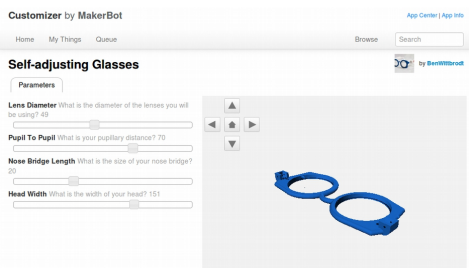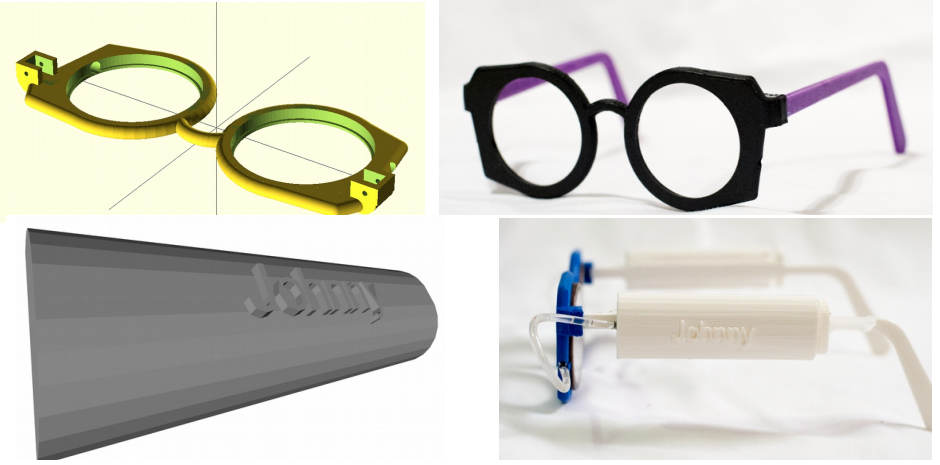Researchers Use 3D Printed Glasses as Case Study in Favor of Introducing Sustainability via 3D Printing
 “You say you want a revolution…”
“You say you want a revolution…”
Well, you should know by now… one is on the way via 3D printing, and exploding out of every viable avenue. When the technology began making great strides and changes in the additive manufacturing arena with items such as making components for automotive and aerospace applications, we began referring to it as the manufacturing revolution. While that’s an apt term, there is certainly about to be a revolution within that regarding sustainability and a new world independence. It’s the type of revolution that all the good guys certainly support — and in the end, there may be some manufacturers wondering what the heck happened to the world as they knew it.
In the December issue of Challenges in Sustainability, some of these issues are well discussed in ‘Reversing the Trend of Large Scale and Centralization in Manufacturing: The Case of Distributed Manufacturing of Customizable 3-D-Printable Self-Adjustable Glasses,’ by Jephias Gwamuri, Ben T. Wittbrodt, Nick C. Anzalone, and Joshua M. Pearce. The authors point out that until recently there weren’t any options for bringing most necessary and desired items, such as prescription strength eyeglasses, to developing countries because of a lack of technology, lack of sustainability, affordability, and a way to get items to those in need.
For most of us, the greatest challenges we have on a daily basis with impaired vision is keeping our glasses smudge-free, or trying to maintain and deal with some of the inconveniences caused by contact lenses. To think that so many individuals have to live with a visual impairment on a constant basis is heartbreaking — not to mention other items such as hearing aids, prostheses, and more.
With the affordability that 3D printing has recently begun to offer, along with the inspiration of the open-sourcing RepRap community and 3D printers that can be produced and replicated from 3D printed parts, the authors point out that now, assuming a 3D printer can be built for $500 or so, and with the aid of CAD software, the following overall benefits should be possible on a large scale:
- Alleviation of poverty in isolated areas
- Manufacturing with minimal environmental impact
- Minimal waste
The researchers used a case study regarding self-adjustable (regarding refraction), 3D printed eyeglasses as an example. They reviewed market, demand, and “the limitations of centrally mass-manufactured self-adjustable glasses.”
The figures regarding the visually impaired in developing and impoverished areas are staggering, with the World Health Organization estimating that roughly 314 million people are visually impaired, with nearly 90% of blind and visually impaired people living in countries with lower to medium scale incomes. Corrective eye care is often an impossibility or scarcity due to lack of doctors, eye care professionals, and of course — eyeglasses. With only a few thousand medical professionals providing eye care to tens of millions of individuals, many are left in the dark, literally. The solution, if paid for through traditional servicing and manufacturing, would cost millions upon millions, from training professionals to purchasing and disbursing equipment — not to mention the whole point, which is in the end, simply distributing prescriptive eyeglasses to those in need.
The authors cite a worldwide statistic that “153 million people over 5 years of age are visually impaired as a result of uncorrected refractive errors.” With the innovative idea that individuals could adjust refraction themselves, a lot of work is cut out of the equation from top to bottom. Using a 3D printed material with Adspec lens/glasses, the “adaptive spectacles offer the user the ability to adjust the refractive power of each lens to achieve self-refraction.”
Vision correction with the Adspec glasses has been tested in African populations and has proven to be a successful, viable method. 3D design and 3D printing come in as a savior to some of the issues currently plaguing the Adspecs in terms of an affordable, sustainable solution:
- Fragile frames
- High cost
- Variations required in frame design
- Lack of aesthetics — and especially when duct-taped after breaking!
3D printing solves all of these problems, from strength to affordability to the flexibility in allowing design variations as well as making expression of individuality available. With an open-source design, changes in design can be allowed for style, hue, and dimensions. Using an OpenSCAD design that is available on Thingiverse, users are allowed all sorts of options, not to mention the whole point of the project, which is independence.
 Printed in PLA on a RepRap, the glasses are able to be 3D printed in under an hour and fully customized for the wearer. Using a “tube and pump system,” the lens can continue to be adjusted for refraction. While the authors point out that a goggle variation may not be quite the look everyone is seeking, it may be just the utilitarian design also required in some areas with heavy sandstorms and dust.
Printed in PLA on a RepRap, the glasses are able to be 3D printed in under an hour and fully customized for the wearer. Using a “tube and pump system,” the lens can continue to be adjusted for refraction. While the authors point out that a goggle variation may not be quite the look everyone is seeking, it may be just the utilitarian design also required in some areas with heavy sandstorms and dust.
Each pair of glasses can be produced for about one dollar.
While there are still obvious obstacles to be addressed in making a plan for the eyeglasses work, it is still more viable than relying on centralized manufacturing to bring eyeglasses en masse to the impoverished at any point. Distribution of 3D printers and computers for design is obviously an initial step, but far easier than expecting centralized manufacturing to reach these areas. The researchers think that a solar-based 3D printer is entirely possibly for making production of the glasses in an ‘off-the-grid’ scenario. While ‘in-the-field’ performance for 3D printers would remain to be seen, the authors do foresee use of recycling with filament and broken or defective prototypes. The potential for lowering costs to even less than a dollar per pair make it well worth it to try and put a plan in place for sustainability.
The authors point out that it’s important to emphasize that this is a case study involving the eyeglasses just as an example. This is a positive argument for many, many other products which can lead to a revolution not just in manufacturing but in sustainability.
Progress in 3D printing is an evolution of technology coming from a highly intelligent worldwide community that is concerned with sharing and improving. This mindset has the potential to help millions of people around the world who have special needs that are already difficult to meet in areas not impoverished, much less those for individuals in developing countries who could not take advantage of all the benefits of mass marketing and production even if they wanted to. In working out the puzzles to meet their needs, it may be that scientists, engineers, and the 3D printing community will work out a way to forge enormous sustainability worldwide.
What do you think of the realities for changing the conditions in impoverished areas by providing sustainability for producing items via 3D printing? Share your thoughts with us in the 3D Printed Eyeglasses Case Study forum over at 3DPB.com.
Subscribe to Our Email Newsletter
Stay up-to-date on all the latest news from the 3D printing industry and receive information and offers from third party vendors.
You May Also Like
Gorilla Sports GE’s First 3D Printed Titanium Cast
How do you help a gorilla with a broken arm? Sounds like the start of a bad joke a zookeeper might tell, but it’s an actual dilemma recently faced by...
Nylon 3D Printed Parts Made More Functional with Coatings & Colors
Parts 3D printed from polyamide (PA, Nylon) 12 using powder bed fusion (PBF) are a mainstay in the additive manufacturing (AM) industry. While post-finishing processes have improved the porosity of...
$25M to Back Sintavia’s Largest Expansion of Metal 3D Printing Capacity Since 2019
Sintavia, the digital manufacturing company specializing in mission-critical parts for strategic sectors, announced a $25 million investment to increase its production capacity, the largest expansion to its operations since 2019....
Velo3D Initiates Public Offering in a Bid to Strengthen Financial Foundations and Drive Future Growth
Velo3D (NYSE: VLD) has been among a number of publicly traded 3D printing firms that have attempted to weather the current macroeconomic climate. After posting a challenging financial report for 2023,...

































